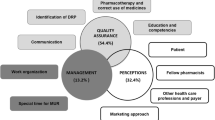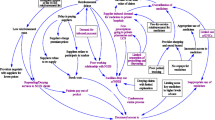Abstract
Background Medicine shortages are an ongoing global problem. The Therapeutic Goods Administration (TGA) dedicated a website for monitoring of medicine shortages in Australia in May 2014, as part of the Medicine Shortage Information Initiative. This study aimed to explore the views of pharmacists regarding medicine shortages in the community setting and the impact of the TGA website in Australia. Setting Community pharmacies in New South Wales, Australia. Method Twenty semi-structured interviews were conducted with community pharmacists. Data collected were analysed thematically utilising the framework analysis method. Main outcome measure Qualitative analysis conducted using the framework approach. Results Findings clearly indicated that medicine shortages were experienced on a regular basis, but most participants were unaware of the TGA website. Medicine shortages reportedly impacted both pharmacists and consumers; and various workarounds were undertaken to manage the issue. The “price disclosure policy” was found to be a prominent contributing factor in emerging shortages. Suggestions were made for ways to improve the growing occurrence of shortages. Conclusion Overall, the study found that there was a lack of familiarity with the TGA website, despite experiencing regular shortages of medicines in practice. Also highlighted, was the importance of pharmacists prioritising patient care over business decisions. To reduce prescribing of out-of-stock medicines notifying doctors about shortages was also considered important, to allow for early action to be taken at higher levels of the supply chain. Findings of this study may help direct future policy-making around the world, as medicine shortages is a problem shared by healthcare providers in most countries around the world.


Similar content being viewed by others
References
Talsma J. Drug shortages still at crisis levels. Drug Top. 2013;157(6):32.
Boyle K. Drug shortages: Canadian strategies for a complex global problem. Health Manage Forum. 2012;25:S48–58.
Johnson PJ. The ongoing drug shortage problem affecting the NICU. Neonatal Netw. 2012;31:323–7.
Krisl JC, Fortier CR, Taber DJ. Disruptions in the supply of medications used in transplantation: Implications and management strategies for the transplant clinician. Am J Transplant. 2013;13:20–30.
Hoffman S. The drugs stop here: a public health framework to address the drug shortage crisis. Food Drug Law J. 2012;67:1–21.
Griffith MM, Gross AE, Sutton SH, Bolon MK, Esterly JS, Patel JA, et al. The impact of anti-infective drug shortages on hospitals in the United States: trends and causes. Clin Infect Dis. 2012;54:684–91.
Fox ER, Sweet BV, Jensen V. Drug shortages: a complex health care crisis. Mayo Clin Proc. 2014;89:361–73.
Gatesman ML, Smith TJ. The shortage of essential chemotherapy drugs in the United States. N Engl J Med. 2011;365:1653–5.
Quilty S, Harris LM, Kewley J, Jones A, Pearce R, James R, et al. A Pandora’s box: sustainable pharmaceutical supply. Med J Aust. 2011;195:510–1.
Goldblatt J, Fletcher JM, McGill J, Szer J, Wilson M. Enzyme replacement therapy “drug holiday”: Results from an unexpected shortage of an orphan drug supply in Australia. Blood Cells Mol Dis. 2011;46:107–10.
Goldsack JC, Reilly C, Bush C, McElligott S, Bristol MN, Motanya UN, et al. Impact of shortages of injectable oncology drugs on patient care. Am J Health Sys Pharm. 2014;71:571–8.
Gagnon MA. Drug shortages: searching for a cure. Healthc Policy. 2012;7(4):10–7.
Huys I, Simoens S. Editorial: European drug shortages: a call for action! Int J Pharm Pract. 2013;21:1–2.
Quilty S. Medicines shortages in Australia—the reality. Australas Med J. 2014;7(6):240–2.
Thompson CA. New FDA law will help preserve production of “life-saving” drugs. Am J Health Sys Pharm. 2012;69:1352–4.
US Food and Drug Administration. [Internet]. Current drug shortages; 2015. [Cited 26 Oct 2015]. http://www.accessdata.fda.gov/scripts/drugshortages/default.cfm.
American Society of Health-System Pharmacists. [Internet]. Drug Shortages: Current Shortages; 2015. [Cited 2015 Oct 26]. http://www.ashp.org/menu/DrugShortages/CurrentShortages.
Chaar BB. Medicine shortages: Implications for the Australian healthcare system. Australas Med J. 2014;7(3):161–3.
Australian Government. [Internet]. Department of Health Therapeutic Goods Administration; 2015. [Cited 2015 Oct 26]. http://www.tga.gov.au/hp/MSI/search/.
Bogucki B, Jacobs BR, Hingle J. Computerized reminders reduce the use of medications during shortages. J Am Med Inform Assoc. 2004;11(4):278–80.
Becker DJ, Talwar S, Levy BP, Thorn M, Roitman J, Blum RH, et al. Impact of oncology drug shortages on patient therapy: unplanned treatment changes. Am Soc Clin Oncol. 2013;9:e122–8.
De Oliveira Jr GS, Theilken LS, McCarthy RJ. Shortage of perioperative drugs: implications for anesthesia practice and patient safety. Anesth Analg. 2011;113:1429–35.
Australian Institute of Health and Welfare. [Internet]. Admitted patient care 2013–2014: Australian hospital statistics; 2015. [Cited 2015 Oct 26]. http://www.aihw.gov.au/publication-detail/?id=60129550483.
The Pharmacy Guild of Australia. [Internet]. Serving Australians: a system of community pharmacy; 2012. [Cited 2015 Oct 26]. http://www.guild.org.au/docs/default-source/public-documents/issues-and-resources/Fact-Sheets/serving-australians-a-system-of-communtiy-pharmacy.pdf?sfvrsn=0.
Ritchie J, Spencer L. Qualitative data analysis for applied policy research. In: Bryman A, Burgess RG, editors. Analyzing qualitative data. London: Routledge; 1994. p. 173–94.
Clarke PM. Challenges and opportunities for the Pharmaceutical Benefits Scheme. Med J Aust. 2012;196:153–4.
Searles A, Jefferys S, Doran E, Henry DA. Reference pricing, generic drugs and proposed changes to the Pharmaceutical Benefits Scheme. Med J Aust. 2007;187(4):236–9.
Kaakeh R, Sweet BV, Reilly C, Bush C, DeLoach S, Higgins B, et al. Impact of drug shortages. Am J Health Sys Pharm. 2011;68(19):1811–9.
Roberts R, Ruthazer R, Chi A, Grover A, Newman M, Bhat S, et al. Impact of a national propofol shortage on duration of mechanical ventilation at an academic medical center. Crit Care Med. 2012;40(2):406–11.
Metzger ML, Billett A, Link MP. The impact of drug shortages on children with cancer—The example of mechlorethamine. New Engl J Med. 2012;367:2461–3.
Ralls MW, Blackwood RA, Arnold MA, Partipilo ML, Dimond J, Teitelbaum DH. Drug shortage-associated increase in catheter-related blood stream infection in children. Pediatrics. 2012;130:e1369–73.
Baumer AM, Clark AM, Witmer DR, Geize SB, Vermeulen LC, Deffenbaugh JH. National survey of the impact of drug shortages in acute care hospitals. Am J Health Sys Pharm. 2004;61(19):2015–22.
Pauwels K, Simoens S, Casteels M, Huys I. Insights in European drug shortages: a survey of hospital pharmacists. Value Health. 2014;17:A14.
Gholami K, Kamalinia G, Attari MMA, Salamzadeh J. Three years evaluation of drug shortages from educational pharmacies in Tehran. Iran J Pharm Res. 2012;11:565–72.
Davis C, Javid PJ, Horslen S. Selenium deficiency in pediatric patients with intestinal failure as a consequence of drug shortage. J Parenter Enteral Nutr. 2013;38:115–8.
Sheth HS, Verrico MM, Skledar SJ, Towers AL. Promethazine adverse events after implementation of a medication shortage interchange. Ann Pharmacother. 2005;39(2):255–61.
Hayes MS, Ward MA, Slabaugh SL, Xu Y. Lessons from the leucovorin shortages between 2009 and 2012 in a medicare advantage population: where do we go from here? Am Health Drug Benefits. 2014;7:264–70.
Skelton Duke M, Chambliss WG, Gardner KN, Norris DM. Mitigating the impact of medication shortages on public health. J Am Pharm Assoc. 2011;51:574–8.
Golembiewski J. Drug shortages in the perioperative setting: causes, impact, and strategies. J Perianesth Nurs. 2012;27:286–92.
Gundlapalli AV, Beekmann SE, Graham DR, Polgreen PM. Perspectives and concerns regarding antimicrobial agent shortages among infectious disease specialists. Diagn Microbiol Infect Dis. 2013;75(3):256–9.
Fox ER, Birt A, James KB, Kokko H, Salverson S, Soflin DL, et al. ASHP guidelines on managing drug product shortages in hospitals and health systems. Am J Health Sys Pharm. 2009;66:1399–406.
Weaver JM. Why are there so many drug shortages? Anesth Prog. 2010;57:89–90.
Lee Ventola C. The drug shortage crisis in the United States causes, impact, and management strategies. Pharm Ther. 2011;36:740–57.
Jensen V, Kimzey LM, Goldberger MJ. FDA’s role in responding to drug shortages. Am J Health Sys Pharm. 2002;59:1423–5.
Born K. Time and money: an analysis of the legislative efforts to address the prescription drug shortage crisis in America. J Leg Med. 2012;33:235–51.
American Society of Health-System Pharmacists. [Internet]. current shortages: chloroquine tablets; 2015. [Cited 2015 Oct 26]. http://www.ashp.org/menu/DrugShortages/CurrentShortages/Bulletin.aspx?id=1178.
US Food and Drug Administration. [Internet]. Current drug shortages: chloroquine phosphate tablets; 2015. [Cited 2015 Oct 31]. http://www.accessdata.fda.gov/scripts/drugshortages/dsp_ActiveIngredientDetails.cfm?AI=Chloroquine Phosphate Tablets&st = c&tab = tabs-1.
Funding
None.
Author information
Authors and Affiliations
Corresponding author
Ethics declarations
Conflicts of interest
None.
Appendix: Interview protocol (for both close and remote areas)
Appendix: Interview protocol (for both close and remote areas)
Step 1
Introduction and greeting.
Step 2
Reiteration of participation options (withdrawal etc.), organise consent form signing and ask for permission to start audio recording.
If participant is in a remote area and the interview is conducted via telephone: Particular care will be taken in acquiring the participant’s express consent [written consent already received prior to the interview] on the record in accordance with the relevant legislation [Telecommunications Act 1997 (CTH) and Listening Devices Act 1984 (NSW)] which prohibits recording of phone interviews without the express consent of all parties.
Step 3
Start interview and allow participant to speak without prompts. Use prompts only if the flow lulls somewhat.
Interview questions
-
1.
What are your general thoughts about medicine shortages?
Prompts:
-
a.
Do you experience medicine shortages in your practice?
-
b.
How often do shortages occur in your practice?
-
c.
What do you know about the causes of medicine shortages?
-
d.
What are the implications and effect on practice of medicine shortages?
-
a.
-
2.
Do you ever use the TGA website dedicated for notification of shortages?
Prompts:
-
a.
When would this be needed?
-
b.
Do you often refer to this website?
-
c.
Is the information on the website accurate?
-
d.
Is there sufficient information on the website for your purposes?
-
a.
-
3.
Do you find the TGA medicines shortages website helpful?
Prompts:
-
a.
In what way is it helpful/unhelpful?
-
b.
Can you provide some examples?
-
a.
-
4.
What do you believe could be done to improve or enhance the website?
-
5.
If you do not believe it is a good intervention, what suggestions do you have about the issue of shortages and what can be done?
Thank the participant and ask if they wish for feedback in the form of a summary of findings.
Rights and permissions
About this article
Cite this article
Tan, Y.X., Moles, R.J. & Chaar, B.B. Medicine shortages in Australia: causes, impact and management strategies in the community setting. Int J Clin Pharm 38, 1133–1141 (2016). https://doi.org/10.1007/s11096-016-0342-1
Received:
Accepted:
Published:
Issue Date:
DOI: https://doi.org/10.1007/s11096-016-0342-1




